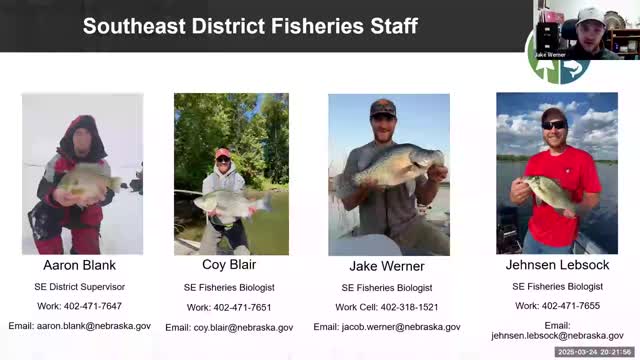Fisheries experts discuss invasive species impact on Nebraska's lakes and new stocking strategies
January 01, 2025 | Nebraska Game and Parks Commission (NGPC), State Agencies, Organizations, Executive, Nebraska
This article was created by AI summarizing key points discussed. AI makes mistakes, so for full details and context, please refer to the video of the full meeting. Please report any errors so we can fix them. Report an error »

The Nebraska Southeast District Fisheries Meeting held on January 1, 2025, focused on critical issues surrounding invasive species and the management of local fisheries. A significant concern raised was the impact of white perch and gizzard shad on native fish populations in the region's reservoirs. Experts highlighted that while these invasive species may initially thrive and provide recreational fishing opportunities, their rapid reproduction ultimately leads to overcrowding and a decline in the growth of desirable sport fish.
The discussion emphasized the importance of preventing the introduction of these invasive species, as their presence can severely disrupt local ecosystems. Officials noted that the primary method of introduction is through human activity, particularly the movement of fish between bodies of water. This underscores the need for public awareness and adherence to regulations prohibiting the use of live bait fish to mitigate the spread of these species.
In addition to addressing invasive species, the meeting provided updates on local fisheries, including Lake Halleck in Papillion. The lake has been stocked with 600 large mouth bass to help control an overabundance of small sunfish, alongside the recent addition of 1,200 rainbow trout. These efforts aim to enhance the fishing experience for local anglers and maintain a balanced ecosystem.
The meeting also explored the potential for expanding smallmouth bass and yellow perch fisheries in the district. While initial trials at Big Elk and Portal lakes have shown promise, ongoing evaluations will determine the feasibility of these fisheries in new locations.
Lastly, officials confirmed that invasive carp species, such as silver and bighead carp, have not yet infiltrated local reservoirs, although they are present in nearby rivers. This highlights the ongoing need for vigilance in managing fish populations and protecting Nebraska's aquatic ecosystems.
The discussions at this meeting reflect a proactive approach to fisheries management, emphasizing the importance of community involvement and regulatory compliance to safeguard local waterways for future generations.
The discussion emphasized the importance of preventing the introduction of these invasive species, as their presence can severely disrupt local ecosystems. Officials noted that the primary method of introduction is through human activity, particularly the movement of fish between bodies of water. This underscores the need for public awareness and adherence to regulations prohibiting the use of live bait fish to mitigate the spread of these species.
In addition to addressing invasive species, the meeting provided updates on local fisheries, including Lake Halleck in Papillion. The lake has been stocked with 600 large mouth bass to help control an overabundance of small sunfish, alongside the recent addition of 1,200 rainbow trout. These efforts aim to enhance the fishing experience for local anglers and maintain a balanced ecosystem.
The meeting also explored the potential for expanding smallmouth bass and yellow perch fisheries in the district. While initial trials at Big Elk and Portal lakes have shown promise, ongoing evaluations will determine the feasibility of these fisheries in new locations.
Lastly, officials confirmed that invasive carp species, such as silver and bighead carp, have not yet infiltrated local reservoirs, although they are present in nearby rivers. This highlights the ongoing need for vigilance in managing fish populations and protecting Nebraska's aquatic ecosystems.
The discussions at this meeting reflect a proactive approach to fisheries management, emphasizing the importance of community involvement and regulatory compliance to safeguard local waterways for future generations.
View full meeting
This article is based on a recent meeting—watch the full video and explore the complete transcript for deeper insights into the discussion.
View full meeting
